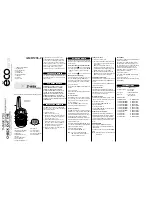
9
RPU416A Software Specifications
.Specifications:
1. Use mechanical knob to choose from 16 channels.
Frequency range: UHF: 450~470MHz
2. Monitor
3. Auto power saving
4. Audio alarm
5. Auto squelch control (0~9 level)
6. Timing
7. Channel space 25kHz/12.5kHz(Wide/Narrow)
8. CTCSS & DQT encode
9. CTCSS & DQT decode
10.Two Tone Signal decode
11.Two Tone Signal encode
12.Busy channel lock
13.Clock frequency deviation
14.Scan
15.PC mode
16.PC modifying mode
17.Wire clone
18.Manual modifying mode
.Description:
1. User mode: general radio mode
2. PC
mode:
Make settings through external programmer or PC program software:
(1) Receive frequency & Transmit frequency
(2) Receive signaling & Transmit signaling
(3) Lock busy channel
(4) Clock frequency deviation
(5) Timing
(6) Squelch level selectivity
(7) Power saving
(8) Audio Alarm
(9) Channel space 25kHz/12.5kHz(Wide/Narrow)
(10) Monitor mode
(11) Scan mode
(12) Reset scan mode
(13) Scan priority
3. PC modify mode:
Make settings through external programmer or PC program software:
RPU416A Software Specifications
(1) Frequency
stability
(2) RF
power
(3) Low power alarm
(4) Squelch (level 9&3)
(5) CTCSS deviation (Wide/Narrow).
(6) DQT deviation (Wide/Narrow).
(7) Receive
sensitivity(low
"
medium
"
high)
4. Wire
Clone:
Press MONI to turn on the power , enter wire clone mode 2 seconds later, press PTT,
Begin cloning while red lights, finish while light goes out.
5. Mode
setting:
(1) Short cut the SELF on PCB, and turn on the power till “BEEP”.
(2) Set channel selector knob to corresponding place according to the model(1-16)
Summary of Contents for RPU416A
Page 19: ...19 Exploded View Packing ...
Page 20: ...20 ...








































